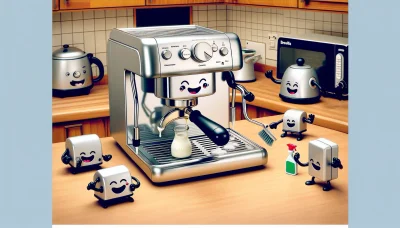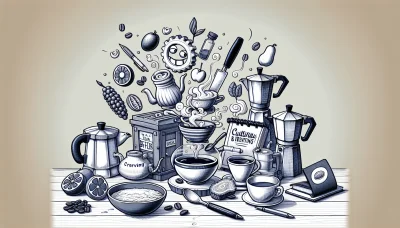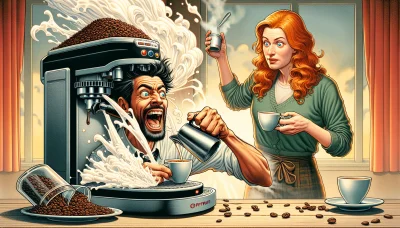Espresso tamper Quiz
Test Your Knowledge
Question of
The Ultimate Guide to Espresso Tamper
An espresso tamper is a tool used in the process of making espresso. It's designed to compact the ground coffee evenly in the espresso machine's portafilter. This is a crucial step because it ensures that the hot water forced through the coffee is distributed evenly, extracting the full flavor and aroma of the coffee. Tampers come in various sizes and materials, but all serve the purpose of creating the perfect espresso shot with a rich crema.
Why is an Espresso Tamper Important?
An espresso tamper is crucial in the process of making a perfect espresso because it ensures that the coffee grounds are evenly compressed in the espresso machine's portafilter. This compression is necessary to create a compact puck of coffee through which hot water can be evenly forced, extracting the full flavor and oils from the coffee beans. Without proper tamping, the water may channel through the coffee grounds unevenly, resulting in an under-extracted or over-extracted espresso. Therefore, a good quality tamper, used with the right technique, is essential for achieving the rich, full-bodied flavor that espresso is known for.
Types of Espresso Tampers
- Flat Tampers
- Convex Tampers
- Calibrated Tampers
- Automatic Tampers
- Level Tampers
How to Choose the Right Espresso Tamper
Choosing the right espresso tamper is essential for making the perfect espresso. The first thing to consider is the size of the tamper, which should fit your espresso machine's portafilter snugly. Typically, tampers range in size from 49mm to 58mm. A tamper that's too small won't provide even pressure across the coffee puck, while one that's too large won't fit in the basket. Material is another important factor; stainless steel tampers are durable and have a good weight, but you can also find tampers made of wood, aluminum, or even glass. The weight of the tamper affects how much pressure you need to apply, so choose one that feels comfortable in your hand. Finally, consider the handle design for ergonomics. A tamper with a handle that fits well in your hand will make it easier to apply the necessary pressure evenly and comfortably. By keeping these factors in mind, you can select the best espresso tamper for your needs and preferences.
Top 5 Espresso Tampers in 2022
| Rank | Product Name | Features | Price | Customer Reviews |
|---|---|---|---|---|
| 1 | LuxHaus 58mm Calibrated Pressure Tamper | Calibrated pressure, stainless steel, ergonomic handle | $40 | 4.8/5 |
| 2 | Espro Calibrated Flat Tamper | Calibrated click feedback, stainless steel, 30lb force feedback | $100 | 4.7/5 |
| 3 | Rattleware 58mm Round-Handled Tamper | Heavy duty, round handle for comfortable grip, stainless steel | $60 | 4.6/5 |
| 4 | Motta 58mm Wooden Handle Tamper | Italian design, wooden handle, stainless steel base | $50 | 4.5/5 |
| 5 | De'Longhi DLSC058 Coffee Tamper | Stainless steel with natural wood handle, 51mm | $30 | 4.4/5 |
How to Use an Espresso Tamper
- Start by grinding your coffee beans to a fine consistency, similar to table salt. This is crucial for a proper espresso extraction.
- Distribute the ground coffee evenly in the portafilter. You can do this by gently shaking the portafilter or using a tool designed for distribution.
- Place the portafilter on a flat, stable surface. This ensures you can apply pressure evenly during the tamping process.
- Hold the tamper like you would a doorknob, with the thumb, index, and middle finger forming a grip around its handle.
- Position the tamper on top of the grounds in the portafilter. Make sure it is level to apply even pressure across all the coffee grounds.
- Apply firm, even pressure straight down until you feel resistance. This is usually around 30 pounds of pressure. Be careful not to use too much force as it could compact the coffee too tightly.
- Once you’ve applied enough pressure, give the tamper a slight twist. This can help seal the coffee grounds and ensure a smooth surface.
- Carefully remove the tamper without disturbing the surface of the tamped coffee.
- Insert the portafilter into the espresso machine and start your extraction.
- Observe the espresso as it brews. A proper tamp should result in a steady stream of espresso with a rich, golden crema on top.
Common Mistakes to Avoid When Using an Espresso Tamper
When using an espresso tamper, many enthusiasts and beginners alike fall into a few common pitfalls that can significantly affect the quality of their espresso shots. One of the most frequent mistakes is not applying even pressure, which can lead to uneven extraction and a less flavorful espresso. Over-tamping is another common error, where too much force compacts the coffee grounds too tightly, restricting water flow and resulting in a bitter taste. Conversely, under-tamping leads to a too-loose coffee puck, causing water to flow through too quickly and producing a weak, under-extracted shot. Lastly, neglecting to maintain a level tamp can cause water to channel through the coffee unevenly, again leading to inconsistent extraction. Avoiding these mistakes can dramatically improve the quality of your espresso shots.
Cleaning and Maintenance of Espresso Tampers
To ensure the longevity of your espresso tamper, regular cleaning and maintenance are crucial. Start by wiping the tamper after each use with a clean, damp cloth to remove coffee grounds and oils. For a deeper clean, disassemble the tamper if possible and wash each part with warm, soapy water, then rinse thoroughly and dry with a soft cloth. Avoid using abrasive materials that can scratch the surface. Store the tamper in a dry place to prevent rusting or damage. Regular maintenance not only keeps your tamper in good condition but also ensures the quality of your espresso shots.
FAQs about Espresso Tampers
- What is an espresso tamper?
- How do I choose the right size tamper for my espresso machine?
- What is the difference between flat and convex tampers?
- How much pressure should I apply when tamping?
- Can the material of the tamper affect the taste of my espresso?
- How do I clean and maintain my espresso tamper?
- Is it worth investing in an expensive tamper?
- Can I use a tamper for making coffee with methods other than espresso?
- What are the signs of an improperly tamped espresso shot?
- Are there any innovative tampers that make the process easier?












